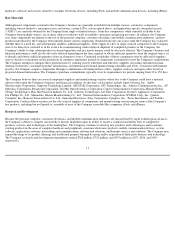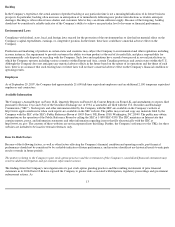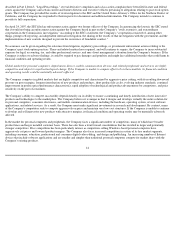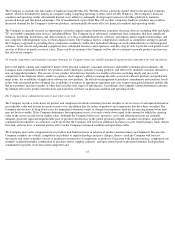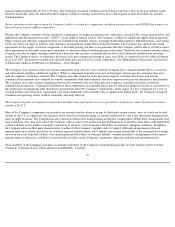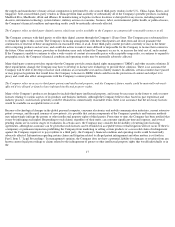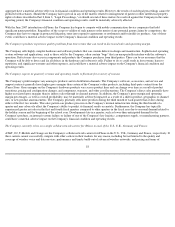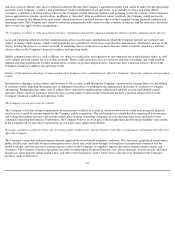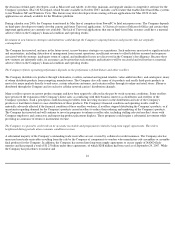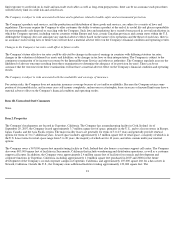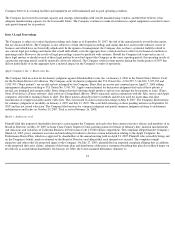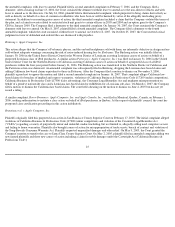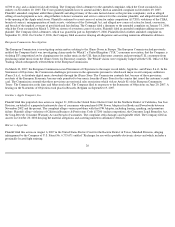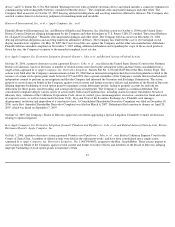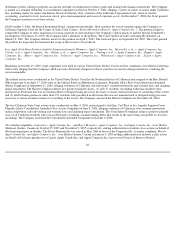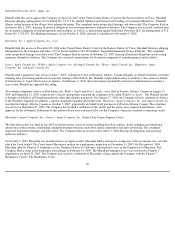Apple 2007 Annual Report Download - page 24
Download and view the complete annual report
Please find page 24 of the 2007 Apple annual report below. You can navigate through the pages in the report by either clicking on the pages listed below, or by using the keyword search tool below to find specific information within the annual report.
The Company has used derivative instruments, such as foreign exchange forward and option positions, to hedge exposures to fluctuations in
foreign currency exchange rates. The use of such hedging activities may not offset more than a portion of the adverse financial effect resulting
from unfavorable movements in foreign exchange rates.
Further information related to the Company's global market risks may be found in Part II, Item 7A, "Quantitative and Qualitative Disclosures
About Market Risk," under the subheading "Foreign Currency Risk," and in Part II, Item 8, "Financial Statements and Supplementary Data," at
Note 1, "Summary of Significant Accounting Polices" and Note 2, "Financial Instruments" of Notes to Consolidated Financial Statements.
The Company's retail initiative has required and will continue to require a substantial investment and commitment of resources and is subject to
numerous risks and uncertainties.
Through September 29, 2007, the Company had opened 197 retail stores. The Company's retail initiative has required substantial fixed
investment in equipment and leasehold improvements, information systems, inventory, and personnel. The Company has also entered into
substantial operating lease commitments for retail space with terms ranging from 5 to 20 years, the majority of which are for 10 years. Certain
stores have been designed and built to serve as high-profile venues to promote brand awareness and serve as vehicles for corporate sales and
marketing activities. Because of their unique design elements, locations and size, these stores require substantially more investment than the
Company's more typical retail stores. A substantial decline in sales, the closure or poor performance of individual or multiple stores, or the
termination of the retail initiative could result in significant lease termination costs, write-offs of equipment and leasehold improvements, and
severance costs that could have a material adverse impact on the Company's financial condition and operating results.
Many factors unique to retail operations, some of which are beyond the Company's control, pose risks and uncertainties that could have a
material adverse effect on the Retail segment's future results, cause its actual results to differ from anticipated results and have a material adverse
effect on the Company's financial condition and operating results. These risks and uncertainties include, among other things, macro-economic
factors that have a negative effect on general retail activity, inability to manage costs associated with store construction and operation, inability
to sell third-party products at adequate margins, failure to manage relationships with existing retail channel partners; lack of experience in
managing retail operations outside the U.S., costs associated with unanticipated fluctuations in the value of retail inventory, and inability to
obtain and renew leases in quality retail locations at a reasonable cost.
The Company's future performance depends on support from third-party software developers. If third-party software applications cease to be
developed and maintained for the Company's hardware products, customers may choose not to buy the Company's products.
The Company believes decisions by customers to purchase the Company's hardware products are often based on the availability of third-party
application software, such as Microsoft Office. There is no assurance that third-party developers will continue to develop and maintain
applications for the Company's hardware products on a timely basis or at all, and discontinuance or delay of these applications could have a
material adverse effect on the Company's financial condition and operating results. The Company believes the availability of third-party
applications depends in part on the developers' perception and analysis of the relative benefits of developing, maintaining, and upgrading such
software for the Company's products versus Windows-based products. This analysis may be based on factors such as the perceived strength of
the Company and its products, the anticipated revenue that may be generated, continued acceptance by customers of Mac OS X, and the costs of
developing such applications. If the Company's minority share of the global personal computer market causes developers to question the
Company's prospects, developers could be less inclined to develop or upgrade software for the Company's products and more inclined to devote
their resources to developing and upgrading software for the larger Windows market. The Company's development of its own software
applications may also negatively affect
21


